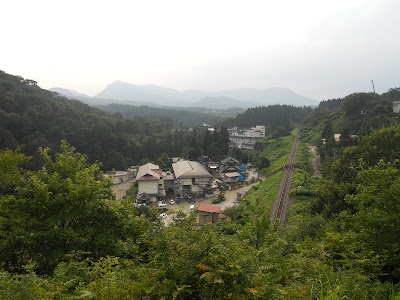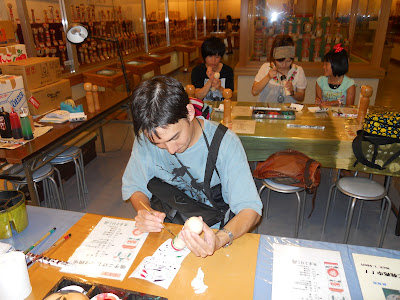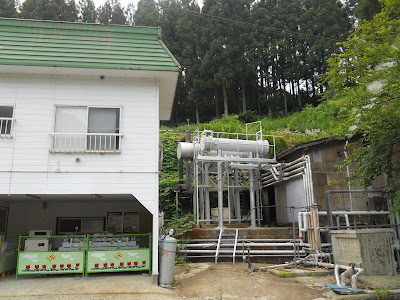Tōhoku's image hasn't had an
easy time. Distant, cold and mountainous, the last region of Honshu
to fall under Japanese consolidation, and once the home of the
mysterious Emishi: aboriginal tribes who resisted the ancient
Japanese tenaciously, and who may or may not have had something to do
with the Ainu; but they faded from the record so long ago that
nobody's really sure who they were now.
Thereafter, Tōhoku developed as
a back-of-beyond agrarian region, too rough and remote to thoroughly
settle, but nonetheless generating a great deal of rice to feed the nation. The dialects can range from
tricky to utterly incomprehensible, though a fair number of its
people pulled off the establishing of rather formidable power bases,
castle towns and regional identities.
First among these centres stands
Sendai, my final port of call on this voyage and base for exploring
the east coast prefecture of Miyagi. Both, along with wider Tōhoku,
are presently most associated with March 2011's triple calamity –
especially to foreigners, for whom it may be the beginning and end of
their knowledge of the region at all.
And yet, I found there a society
keenly aware of itself and the destiny it's had to forge in the
shadow of the southern political heavyweights, or of the wilder
exciting frontiers to the north. And Tōhoku's nature, while not
unbound and vast like Hokkaido's, offers a beauty of its own: one of
concentrated secrets and stalwart local traditions, hidden away
amidst the forested hot springs and mountain passes of Japan's upper
spine.
As with the Namahage of Oga, it was a video game that brought me to Naruko. Nestled
in the high ravines towards the border with Yamagata, this spa town
and its neighbouring villages sit amidst natural hot springs which
fill the air with a sulphurous fragrance. It is one of about a dozen
onsen regions associated with a very peculiar Tōhoku tradition.
These are Kokeshi: one standing,
one sitting. They date back at least two or three hundred years into
the middle Edo period, when they were developed at onsen (hot
spring) resorts like Naruko by local woodwork artisans, and sold to
visitors or given as presents to children. For some they also
acquired spiritual meanings: talismans for good harvests or elemental
protection. Among traditional wooden Japanese toys, Kokeshi lead from
the front here.
They have travelled well over
these centuries. The video game where I first encountered them, on
the now ancient Nintendo 64, was a side-scrolling adventure game
featuring massive Kokeshi whose heads or bodies would separate, and
come crashing down as platforms you had to negotiate (and if your
memory is good enough to recognize which game, I raise my hat to
you!). And their presence in that field persists in influencing the
Mii avatars on Nintendo's Wii console. Each of the dozen onsen
they came from is now famous as an authentic traditional Kokeshi
producer, and while they all preserve this heritage, each produces
the dolls in its own distinctive local style.
And as for the Kokeshi dolls
themselves, they have flown from their workshops to make their
respective hot spring villages renowned in their image, such that you
know this is Kokeshi territory well before you have stepped off the
train. Their shapes and faces dominate storefronts, windows,
signposts and even telephone booths, while local Kokeshi stores and
workshops abound on every street. It would be a fair estimate that
there are now more Kokeshi than people.
As these fellows from the JR
Naruko-Onsen Station testify, the Kokeshi's underlying head-and-body
structure gives them great flexibility in embracing anything
modernity confronts them with. Here are some more, courtesy of
Naruko's Kokeshi museum.
I find this powerful. Kokeshi
have such potency to be a handshake between ancient and modern,
traditional and innovative, past and future, forces which too often
pull in opposite directions and struggle to understand one another.
On the one hand, the simple yet authentic head and cylinder: you
cannot mistake it for anything else. On the other, its open wooden
canvas, on which you can create any design you like. Whatever it
becomes is at once an artistic expression of the person who drew it –
their imagination, their character – and at once a connection to
Tōhoku's abiding provincial heritage.
The museum is especially splendid
for the insight it gives into how Kokeshi are made. It is a process
that starts with specific woods: the light mizuki, or the
darker and more expensive cherry. The wood must be dried for months
or years, before it is sawn and placed on one of these.
The wood-turner spins the wood
round and round, and allows you to shape and polish it into a fine
cylinder. The head is also so crafted, then plugged into a hole dug
in the cylinder's neck.
Then you can paint it. Black, red
and green are the most traditional colours, though some – including
the Naruko style – have come to sport glorious yellow too.
With thanks to the museum for the
opportunity, I decided to give it a go. Here, upon a certain
inspiration, is my amateur
contribution to the annals of Naruko's Kokeshi heritage.
Just below the town and museum
area is Naruko Gorge, a breathtaking 100-metre-deep ravine well known
for its late autumn colours. Sadly, I found that the path along the
bottom of the gorge is currently closed off for safety reasons, but
there is still some magnificent hiking there through the fabulous
summer greenery.
And this is what it's meant to
look like in autumn:
There are plenty of curious
little creatures around there. Keep an eye out for the tons of cute
green crickets – you'll be surprised how far they can jump.
This region is also known for the
travels of Matsuo Bashō, seventeenth-century poet and explorer and
key figure in – among much else – the development of haiku,
who wandered deep into these northern frontiers to find inspiration.
His most famous journey took him west of Sendai through these very
gorges and mountain passes. This was demanding terrain for all its
steep climbs, rough weather and bridgeless rivers crossings, all the
more dangerous as a strategic east-west mountain highway between the
old Mustu and Dewa provinces, amidst inter-domain tensions, roaming
bandits, and military checkpoints.
It was in these parts, high in
the mountains, that Bashō and his travelling companion Sora were
overtaken by a massive storm and stranded in a hut for three days.
 |
'蚤虱馬の尿する枕もと'
'Bitten by fleas and lice,
I slept in a bed,
A horse urinating all the
time
Close to my pillow.'
|
Most of the actual sights and
structures Bashō encountered are long gone, but on any hike around
this region you are sure to run into their sites. These now have
signs that commemorate his journey, and explain – with impressive
detail in English – its local episodes in context.
I also came across this curious
installation:
As an abundantly volcanic country
of thousands of onsen, one might imagine Japan has great sources of clean geothermal energy. Shockingly, despite the
sustainability crisis, Japan's renewable energy sector is embryonic;
and in the light of this and the ongoing fury of the nuclear dispute,
one wonders why geothermal seems so unexplored and untapped in what
appears one of its most promising countries in the world.
All the more so since the huge
advances in infrastructure since Bashō wandered through here, making
these narrow areas so easy to reach nowadays. Naruko is only two
hours from Sendai by train, yet loses none of the charm of its sense
of fresh isolation.
I wonder if these issues are
being considered, but at the same time hope that any such
explorations would take all care to preserve that atmosphere; as well
as account for the prospects for onsen managers and residents.
And no, I didn't actually visit
any onsen. Not one on this entire trip. In part I didn't get time,
but it also arose from my dislike for gender-segregated environments.
It seems that traditionally, males and females used onsen
together; but with the coming of Western ideas in the Meiji era, one
unfortunate influence was the West's mad notion that men and women
are fundamentally different species, forever to interact with tension
and mutual misunderstanding and be forced into separate spaces in
public institutions.
Thus,
most onsen
in Japan today have separate male and female areas, and my discomfort
with artificial gender segregation thus defeats the point of going to
onsen
at all: that is, to relax. Though there are still mixed onsen
around (kon'yoku,
混浴),
particularly in rural areas, I unfortunately lacked the time to
pursue this on this trip.
In the
next entry: Sendai itself, the powerhouse of Tōhoku
and the layers of pride and pain it bears on its journey.
Previous posts in this series:




































No comments:
Post a Comment